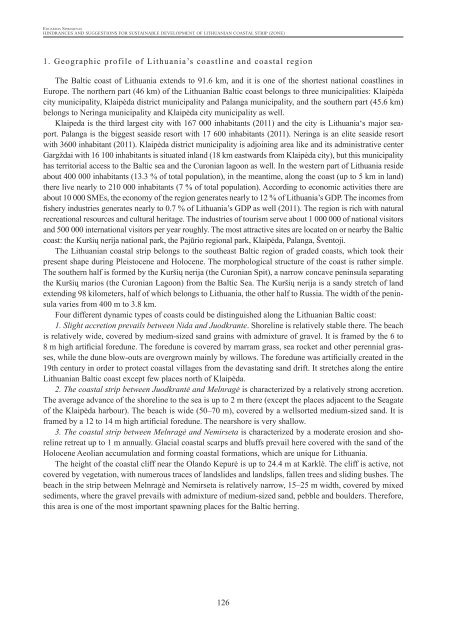Regional Formation 2012,1 - KlaipÄdos universitetas
Regional Formation 2012,1 - KlaipÄdos universitetas
Regional Formation 2012,1 - KlaipÄdos universitetas
Create successful ePaper yourself
Turn your PDF publications into a flip-book with our unique Google optimized e-Paper software.
Eduardas Spiriajevas<br />
HINDRANCES AND SUGGESTIONS FOR SUSTAINABLE DEVELOPMENT OF LITHUANIAN COASTAL STRIP (ZONE)<br />
1. Geographic profile of Lithuania’s coastline and coastal region<br />
The Baltic coast of Lithuania extends to 91.6 km, and it is one of the shortest national coastlines in<br />
Europe. The northern part (46 km) of the Lithuanian Baltic coast belongs to three municipalities: Klaipėda<br />
city municipality, Klaipėda district municipality and Palanga municipality, and the southern part (45.6 km)<br />
belongs to Neringa municipality and Klaipėda city municipality as well.<br />
Klaipeda is the third largest city with 167 000 inhabitants (2011) and the city is Lithuania‘s major seaport.<br />
Palanga is the biggest seaside resort with 17 600 inhabitants (2011). Neringa is an elite seaside resort<br />
with 3600 inhabitant (2011). Klaipėda district municipality is adjoining area like and its administrative center<br />
Gargždai with 16 100 inhabitants is situated inland (18 km eastwards from Klaipėda city), but this municipality<br />
has territorial access to the Baltic sea and the Curonian lagoon as well. In the western part of Lithuania reside<br />
about 400 000 inhabitants (13.3 % of total population), in the meantime, along the coast (up to 5 km in land)<br />
there live nearly to 210 000 inhabitants (7 % of total population). According to economic activities there are<br />
about 10 000 SMEs, the economy of the region generates nearly to 12 % of Lithuania’s GDP. The incomes from<br />
fishery industries generates nearly to 0.7 % of Lithuania’s GDP as well (2011). The region is rich with natural<br />
recreational resources and cultural heritage. The industries of tourism serve about 1 000 000 of national visitors<br />
and 500 000 international visitors per year roughly. The most attractive sites are located on or nearby the Baltic<br />
coast: the Kuršių nerija national park, the Pajūrio regional park, Klaipėda, Palanga, Šventoji.<br />
The Lithuanian coastal strip belongs to the southeast Baltic region of graded coasts, which took their<br />
present shape during Pleistocene and Holocene. The morphological structure of the coast is rather simple.<br />
The southern half is formed by the Kuršių nerija (the Curonian Spit), a narrow concave peninsula separating<br />
the Kuršių marios (the Curonian Lagoon) from the Baltic Sea. The Kuršių nerija is a sandy stretch of land<br />
extending 98 kilometers, half of which belongs to Lithuania, the other half to Russia. The width of the peninsula<br />
varies from 400 m to 3.8 km.<br />
Four different dynamic types of coasts could be distinguished along the Lithuanian Baltic coast:<br />
1. Slight accretion prevails between Nida and Juodkrante. Shoreline is relatively stable there. The beach<br />
is relatively wide, covered by medium-sized sand grains with admixture of gravel. It is framed by the 6 to<br />
8 m high artificial foredune. The foredune is covered by marram grass, sea rocket and other perennial grasses,<br />
while the dune blow-outs are overgrown mainly by willows. The foredune was artificially created in the<br />
19th century in order to protect coastal villages from the devastating sand drift. It stretches along the entire<br />
Lithuanian Baltic coast except few places north of Klaipėda.<br />
2. The coastal strip between Juodkrantė and Melnragė is characterized by a relatively strong accretion.<br />
The average advance of the shoreline to the sea is up to 2 m there (except the places adjacent to the Seagate<br />
of the Klaipėda harbour). The beach is wide (50–70 m), covered by a wellsorted medium-sized sand. It is<br />
framed by a 12 to 14 m high artificial foredune. The nearshore is very shallow.<br />
3. The coastal strip between Melnragė and Nemirseta is characterized by a moderate erosion and shoreline<br />
retreat up to 1 m annually. Glacial coastal scarps and bluffs prevail here covered with the sand of the<br />
Holocene Aeolian accumulation and forming coastal formations, which are unique for Lithuania.<br />
The height of the coastal cliff near the Olando Kepurė is up to 24.4 m at Karklė. The cliff is active, not<br />
covered by vegetation, with numerous traces of landslides and landslips, fallen trees and sliding bushes. The<br />
beach in the strip between Melnragė and Nemirseta is relatively narrow, 15–25 m width, covered by mixed<br />
sediments, where the gravel prevails with admixture of medium-sized sand, pebble and boulders. Therefore,<br />
this area is one of the most important spawning places for the Baltic herring.<br />
126
















